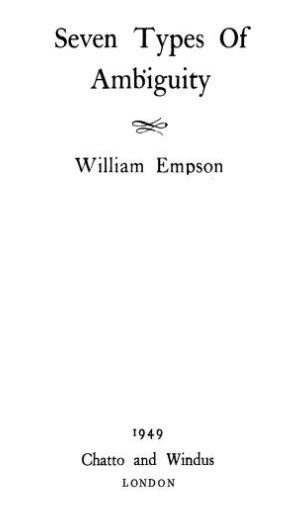‘William Empson Seven Types Of Ambiguity’ PDF Quick download link is given at the bottom of this article. You can see the PDF demo, size of the PDF, page numbers, and direct download Free PDF of ‘Seven Types Of Ambiguity’ using the download button.
Seven Types Of Ambiguity Full Text PDF Free Download

Seven Types Of Ambiguity
In common parlance, fallacy means something declared very prosaically, and usually witty or deceitful.
I propose to use the term in an extended sense and will consider relevant to my subject any verbal nuance, no matter how small, that gives room for alternative responses to the same piece of language.
Sometimes, especially in this first chapter, the term can be absurdly stretched too far, but it is descriptive because it suggests an analytical way of approach, and that is what concerns me.
In a sufficiently extended sense, any prose statement can be said to be ambiguous. First of all it can be analyzed.
Thus, ‘The brown cat sat on the red mat’ can be broken down into a series: “This is a statement about a cat. The cat that the statement is made about is brown, and so on.”
Each such simple statement can be translated into a complex statement that employs other words.
Thus you now have the task of explaining what a ‘cat’ is, and each such complication can again be analyzed into a simpler series.
Thus everything that makes up the ‘cat’ will stand in some spatial relation to the ‘mat’.
Explanation, based on the choice of words, can be done in any direction the interpreter wishes; Thus translating and analyzing the notion of “being” might involve a course in anatomy; The notion of ‘at’ on the theory of gravity.
However, such a course would be irrelevant not only to my purpose in this essay, but also to the context contained in the statement, irrelevant to the person to whom it appears to be addressed.
and the purpose for which it appears to be addressed to him; Nor will you be able to discover anything very fundamental about the sentence by analyzing it in this way.
You would simply be making up another sentence, stating the same fact, but designed for a different purpose, context, and person.
Obviously, literary critics are very concerned with implications of this last kind and should consider them to be the core of the meaning.
It is not his main, or even his immediate concern, that a word can be interpreted, that a sentence can be meant in a great number of ways; If he makes it his concern, there is a danger that, in the calculation of these methods, judgments of value will be forgotten.
And unless they are placed at the beginning of an analysis, they do not automatically appear at the end.
Many of Mr. Empson’s analyzes seem to have no proper critical conclusion; They are only as interesting as the revelation of the poet, or the ingenious mind of Mr. Empson.
Furthermore, some of Mr. Empson’s analysis deals not with words and sentences, but with the conflicts that raged within the author as he wrote.
Here it seems to me that perhaps he has completely left poetry behind. ,
There are many inconsistencies in Mr. Empson’s book, and just as they arise to a degree, perhaps to a degree they are aggravated, by his obscurity as to the nature and scope of the obscurity.
Finding it everywhere in drama, in our social experience, in the fabric of our mind, he assumed that it must be sought everywhere in great poetry.
I doubt whether the reader who remembers his Sappho, his Dante, or the lucid poems of Wordsworth is prepared to be convinced of this; But even if it had been so, it could not have been so until Mr. Empson had made his position very clear.
What ambiguity refers to life – is it a conglomerate of diverse forces, bound together only by their coexistence?
Or is it a literary device – of allusion, conceit, or pun, in one of their more or less conscious forms?
If the first, Mr. Empson’s thesis is entirely wrong; Because poetry is not just a slice of life; It is a piece taken apart, perceived and judged by the mind.
A poem is a noun rather than a phenomenon. If the second, then at least we can say that Mr. Empson’s thesis is exaggerated.
| Author | William Empson |
| Language | English |
| Pages | 286 |
| PDF Size | 24.5 MB |
| Category | Literature |
Seven Types Of Ambiguity PDF Free Download
